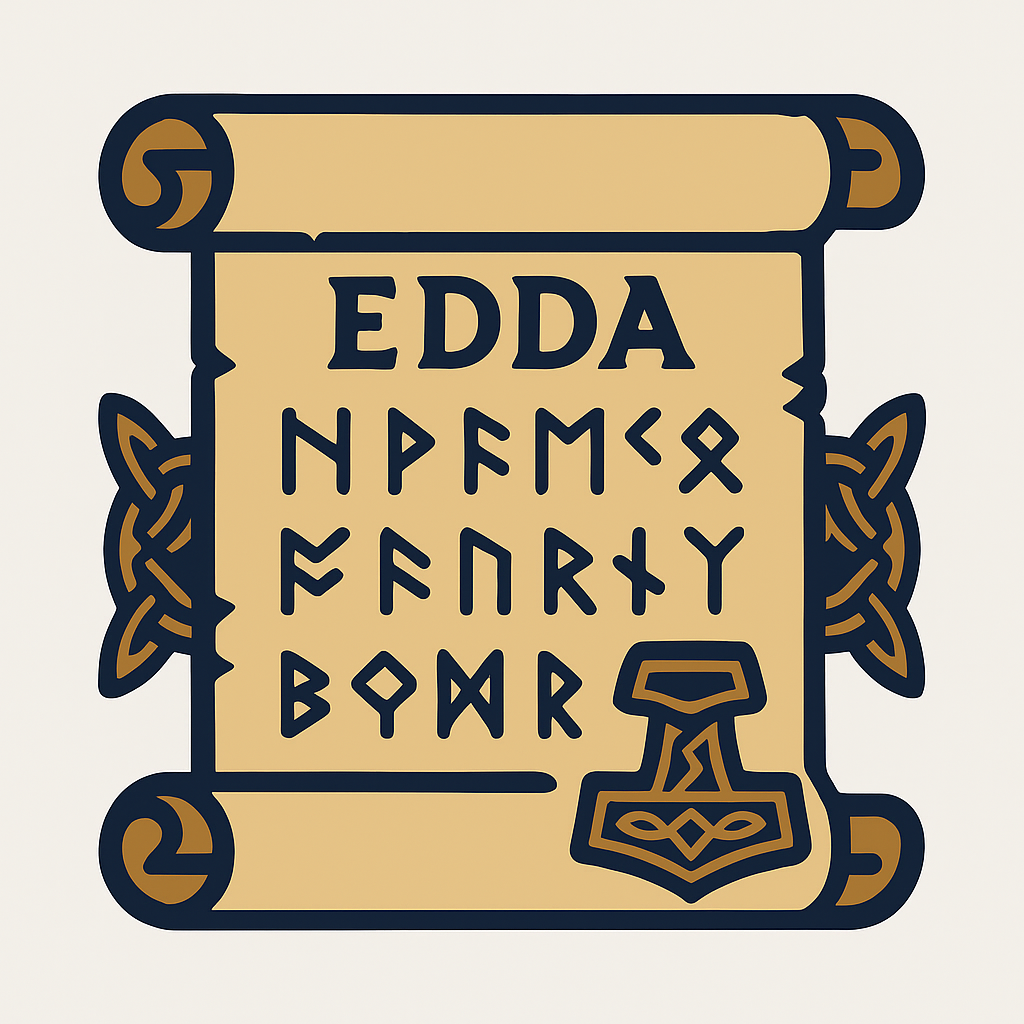

The Poetic Edda is one of the most significant surviving texts of Old Norse literature. Written down in Iceland in the 13th century, yet preserving material from much earlier oral traditions, the Edda is the backbone of our knowledge about Norse mythology. Without it, we would know little about the gods Odin, Thor, Freyja, Loki, or the great cosmic drama of Ragnarök.
This article provides an overview of the Poetic Edda, its origins, contents, and importance for both historical study and modern culture. Along the way, we will see how this medieval text continues to shape our fascination with the Viking Age.
⚡ Channel Thor’s Strength — Thor Hoodie
👕 Thor Long Sleeve Available Here
The term Edda refers to two main works: the Poetic Edda (sometimes called the Elder Edda) and the Prose Edda by Snorri Sturluson. The Poetic Edda is a collection of anonymous Old Norse poems preserved in a single manuscript called the Codex Regius, written around 1270 in Iceland (Larrington, 2014).
Although the manuscript dates to the 13th century, scholars believe that many of the poems were composed between the 9th and 12th centuries, and some may preserve even older oral traditions going back to the Viking Age.
The Codex Regius (“Royal Book”) is the sole surviving manuscript of the Poetic Edda. It was discovered in 1643 by Bishop Brynjólfur Sveinsson, who presented it to the King of Denmark, hence its name. The book eventually returned to Iceland in 1971, where it is now housed in Reykjavík’s Árni Magnússon Institute (Faulkes, 1995).
The manuscript contains 31 poems. Roughly half of them deal with mythology, recounting the deeds of gods such as Odin, Thor, and Loki. The other half are heroic lays, narrating the exploits of legendary heroes like Sigurd the dragon-slayer.
The mythological poems are often divided into three categories:
Cosmogonic Poems – dealing with the creation of the world, such as Völuspá (“The Prophecy of the Seeress”).
Poems of the Gods – recounting stories about Odin, Thor, Loki, and others, such as Hávamál (“Sayings of the High One”) and Þrymskviða (the tale of Thor’s stolen hammer).
Heroic Poems – recounting the tragic fates of mortal heroes like Sigurd and Brynhild, influenced by the broader Germanic legend cycle.
🦅 Embody Odin’s Wisdom — Odin Hoodie
👕 Odin T-shirt coming soon — full set upgrade awaits!
The Poetic Edda is written in a distinctive form of Old Norse verse, using meters such as fornyrðislag (“old story meter”) and ljóðaháttr (“song meter”). These forms rely on alliteration rather than rhyme, and their compact style suited oral recitation.
For example, in Völuspá, the seeress describes the birth of the cosmos:
“In the beginning was Ymir,
no sand, no sea, no cool waves,
no earth, no sky, no grass, no nothing —
only the gaping void of Ginnungagap.” (Larrington, 2014)
This fragment illustrates how the Edda’s poetry is both stark and profound, evoking cosmic ideas with minimal words.
The Eddic poems reveal a worldview shaped by fate, honor, and the inevitability of death. The gods themselves are not immortal: Odin will fall to Fenrir, Thor to the Midgard Serpent, and the cosmos itself will end in Ragnarök — only to be reborn.
✨ Honor Freya’s Power — Freya Hoodie
🌸 Freya Tee Available Here
This tragic but heroic vision resonates with modern readers: life is short, fate is inescapable, but courage and honor give meaning.
The Poetic Edda should not be confused with the Prose Edda, written by Snorri Sturluson around 1220. Snorri’s work was a handbook for poets, explaining mythological stories so that skalds (court poets) could compose verses filled with traditional kennings (metaphorical expressions).
While Snorri relied heavily on oral tradition and earlier poetry, the Poetic Edda preserves the poems themselves, making it invaluable as a direct source of myth (Simek, 2007).
When the Codex Regius was rediscovered in the 17th century, it revolutionized the study of mythology in Europe. Poets and scholars in the Romantic era — such as William Blake, Richard Wagner, and later J.R.R. Tolkien — were deeply inspired by its contents.
🔥 Loki gear coming soon — stay tuned, trickster fans!
🌟 Baldr collection in development — purity meets power!
Today, the Poetic Edda continues to inspire novels, films, video games, and even fitness culture — where Norse gods symbolize endurance, strength, and defiance of fate.
Beyond its historical and literary value, the Poetic Edda continues to shape our cultural imagination. From Marvel’s cinematic Thor to Viking-themed sports apparel, its stories remain alive. For scholars, the Edda is a key to the Viking mind; for enthusiasts, it is a treasure chest of myth, mystery, and inspiration.
The Poetic Edda is not just a relic of medieval Iceland — it is a living document of human imagination. Its myths of creation and destruction, gods and monsters, courage and fate, still speak to us today. Whether studied in the classroom or invoked in popular culture, the Edda remains one of the most powerful gateways to the world of the Norse.
Larrington, Carolyne (trans.). The Poetic Edda. Oxford University Press, 2014.
Faulkes, Anthony. Edda. Everyman, 1995.
Simek, Rudolf. Dictionary of Northern Mythology. Boydell & Brewer, 2007.